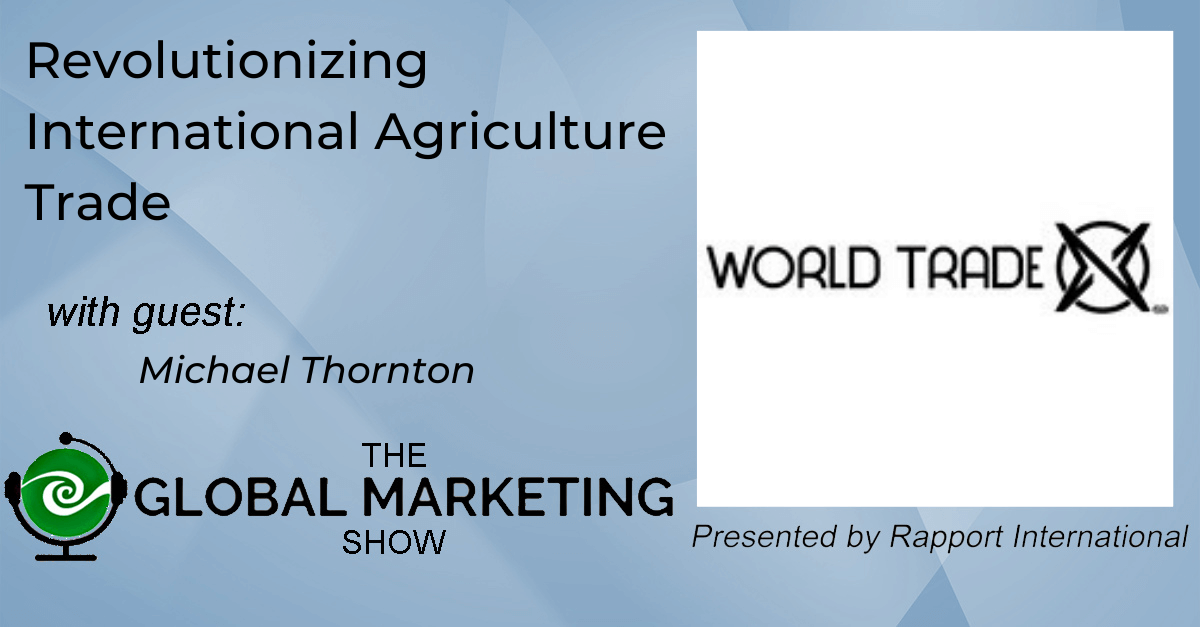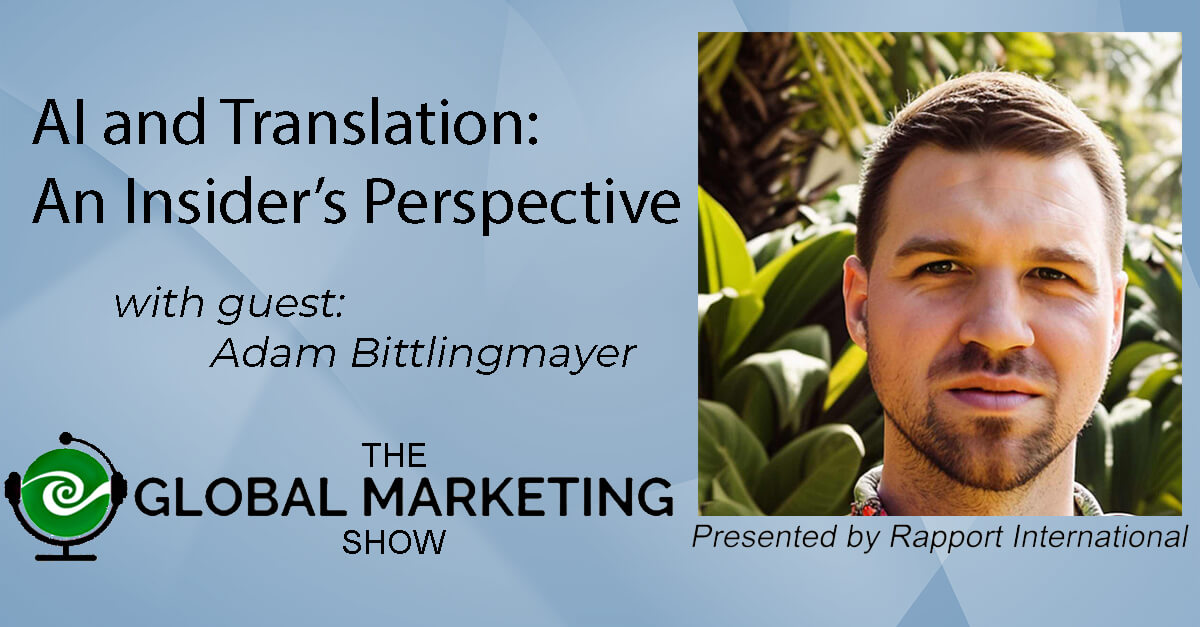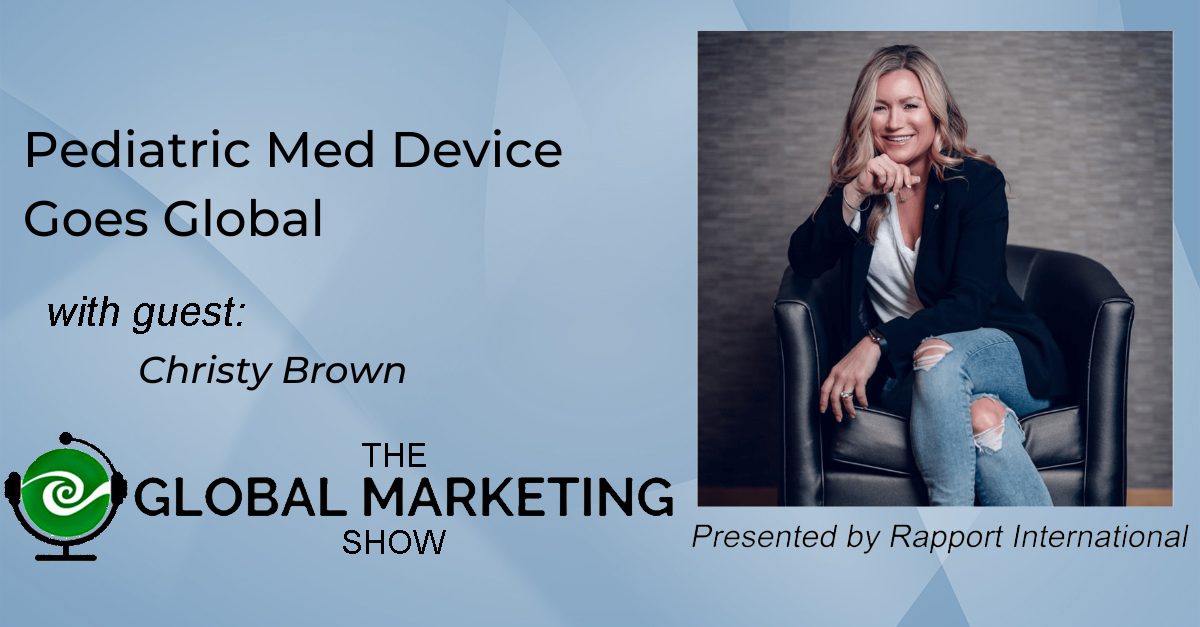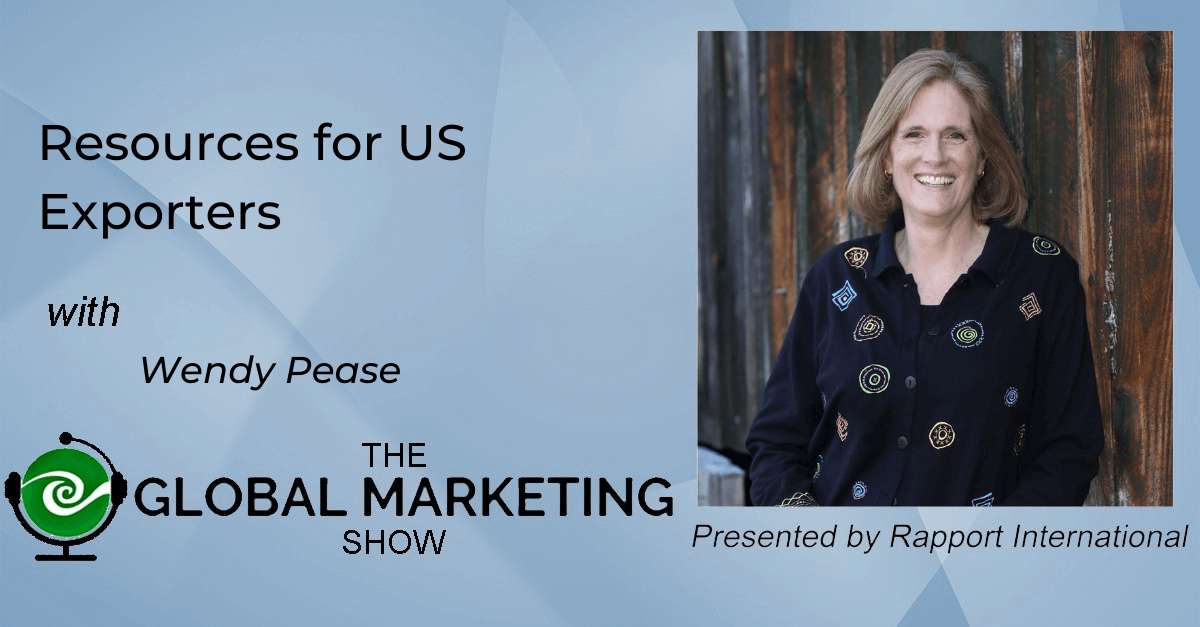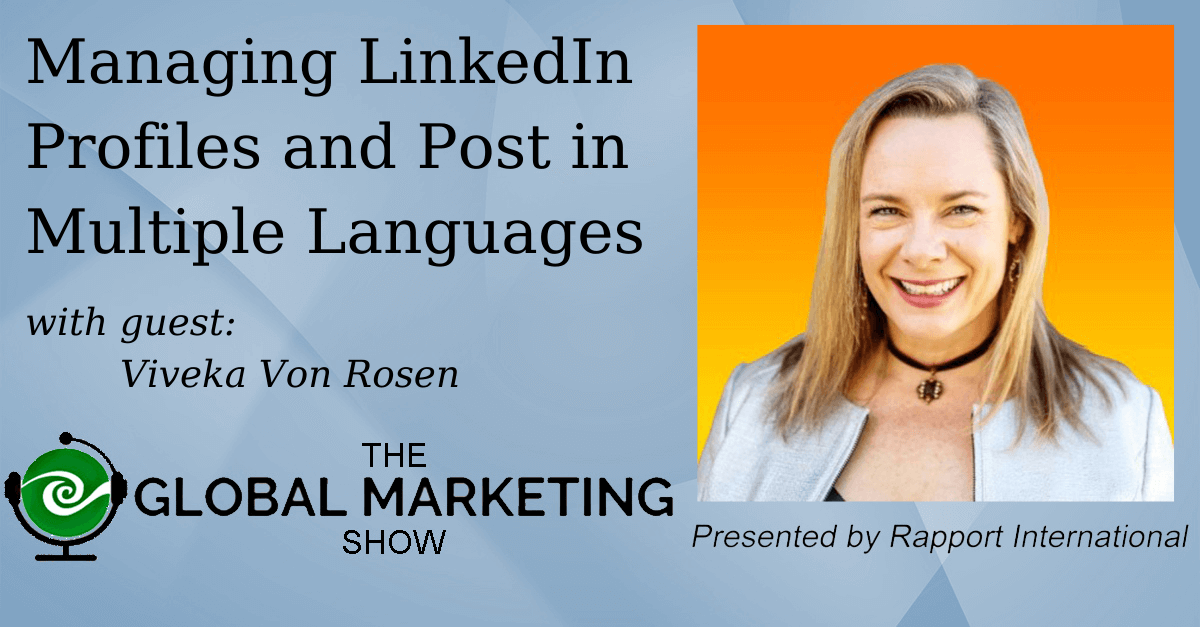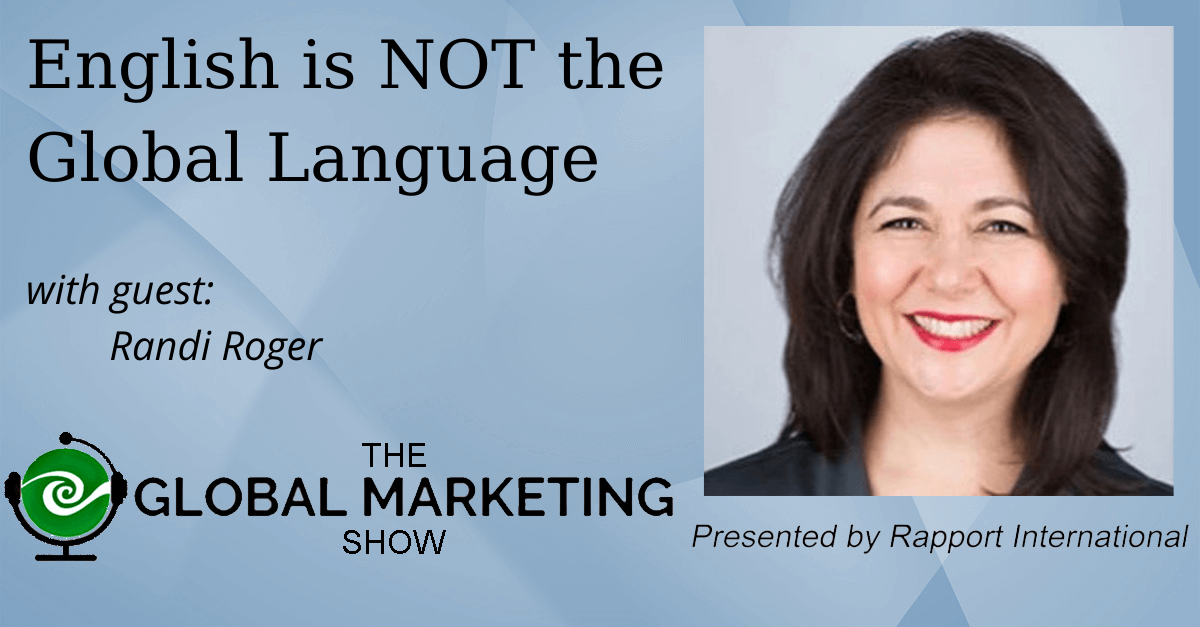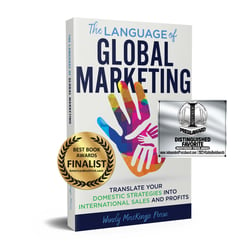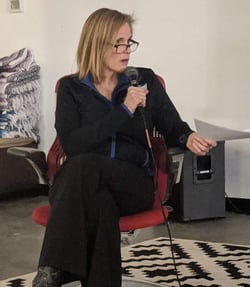Nina Ann Waters is the founder and Managing Director of Expandise, which helps growth-stage companies execute and manage international expansion. She has helped companies navigate the complexities of launching in over 26 different countries - a truly fascinating feat!
In this episode, she outlines the language requirements for successful global branding, including best practices and common missteps, the importance of in-country support, and the key to impactful market entrée in any country.
Language Landmines to Avoid
First and foremost, Nina advises, be especially cautious of word choices when expanding into new markets, even when you’re dealing with other English-speaking countries like the UK.
Subtle linguistic differences can have major implications, especially for e-commerce businesses, Nina continues. Something as simple as using the word "pants" (rather than “trousers”) on a UK-facing website would instantly signal to customers that it's an American company, which can negatively impact trust and conversion rates.
"People generally prefer to do business with local companies," she said. "The more local you can make your business look, the better it's going to be for consumers. Because it's also going to appeal to their comfort level."
Adapting to Local Languages and Customs
In addition, Nina says that truly succeeding in international markets requires adapting to local languages and cultural norms. Issues can arise even around the smallest details. In one instance, an Expandise client simply could not accommodate Polish character sets in its logistics systems, denying them entrée into a potentially lucrative market.
Conversely, preparing for translation from the outset allows you to fully adapt your products, marketing, and operations to each new market rather than simply translating a message that may fall flat. Take the time to understand local consumer preferences, payment methods, and even delivery expectations.
Similarly, there are challenges involved with adapting management styles when working across different cultural contexts. Nina illustrates the contrast between her preferred "hands-off, goal-oriented" approach and the more hierarchical, step-by-step management style that was common in Indonesia. Only when leadership is open to learning and adjusting their management style will companies create engaged and productive teams in unfamiliar cultural environments.
The Value of In-Market Expertise
Nina also advises her clients to work closely with local experts when expanding into new markets. These on-the-ground connections can save companies weeks or even months of time by providing crucial insights that may not be readily available online.
Local expertise gives companies a competitive advantage when it comes to understanding cultural nuances, identifying the right marketing channels, and navigating regulatory and legal requirements.
Nina suggests hiring junior-level employees who can be trained in various aspects of the business, such as online marketing or logistics. This approach provides flexibility – probationary periods or fixed-term contracts, for example – and allows the company to retain talented individuals even if the initial market entry doesn't work out as planned.
Key Strategies for Successful Expansion
Despite the potential pitfalls, she emphasized that global expansion can be tremendously rewarding for businesses. At the same time, she describes the failure rate for international expansions as shockingly high, around 80%.
Again, "the main reason for this is a failure to adapt properly to the local market," she says. "And that doesn't just mean in terms of the product or service, which is a big part of it, but clients or companies often expect what works in their home market to work exactly the same in a new market. And that often isn't the case."
To avoid becoming part of this statistic, companies should take a methodical, data-driven approach to market selection and entry. This includes conducting thorough competitor analysis and assessing market size, pricing, and staffing considerations, all while keeping a keen eye on cultural factors.
She also stresses the importance of having adequate resources and a willingness to build relationships rather than just expecting customers to flock to a new market.
Her best advice? Approach international expansion with a strategic mindset, a willingness to learn, and a commitment to delivering a high-quality, localized experience to customers worldwide. Listen to the full episode for more practical insights and advice.
Links:
LinkedIn: https://www.linkedin.com/in/ninaannwalters/
Connect with Wendy: https://www.linkedin.com/in/wendypease/
Music: Fiddle-De-Dee by Shane Ivers - https://www.silvermansound.com
ATTENTION: Below is a machine-generated transcription of the podcast. Yes, here at Rapport International we talk a lot about how machine translation lacks quality. Here you see an example of what a machine can do in your own language. This transcription is provided as a gist and to give time indicators to find a topic of interest.
Wendy: Welcome everybody to the Global Marketing Show. I'm glad you could join us today. It's going to be a special treat as I welcome Nina Ann Walters. She has experience in ECommerce in over 26 different countries, which I find fascinating. And she is also hysterical when she starts talking about the differences [00:01:00] between UK and US English.
So welcome, Nina. Great to have you here.
Nina Ann Walters: Hi. Thanks for having me. I'm really excited to be here today.
Wendy: You know, in your introduction I forgot to mention what you do. You were the managing director of Expandise. That's right. So, yeah, do you want to tell us a little bit more about what you do, and then we're going to get into the differences between the US and UK English.
Nina Ann Walters: Sure, yeah. So Expandise is an internationalization consultancy helping companies to expand in other countries. So we have, as you can probably tell, I'm British. So we do have an office in London. But I've now lived in Germany for almost a decade. So I'm now also a German. So we have offices in both countries and we help companies develop their international strategies, decide what markets they should enter into, and help them adapt their products for the new markets.
We then also join the companies in house to help project manage their launches and drive the first few phases of growth into new markets.
Wendy: Excellent. All right, so [00:02:00] we're going to get into that more as we go along, but, but talk to me about if I'm a U. S. company going into the U. K., what language issues am I going to run into?
Nina Ann Walters: The first thing that I always say is, I'll ask companies is if they need a translator at that point, and if they want me to translate for them.
Wendy: It sounds funny for English, but we've done translation for companies going into the UK. They had to.
Nina Ann Walters: Yeah, absolutely. It's not the same. People don't react to the same kind of language, and it's not the same at all.
To take a slightly, I'll give you sort of a safe example and a provocative one. Let's go for the provocative one. As a British person going to the States, if people are asking for a cigarette, it's, people here will say, Hey, can I bum a fag? Which means something very, very different in the States to what it means in England.
But in England, a fag is only used for a cigarette. So, obviously that's something that I've heard a lot of stories about going very [00:03:00] wrong in the US when people use their, their normal terminology. On the other hand, I had a friend here, came into London, and he was the only American in the group and there was sort of a group of us sitting around having lunch.
And he was in the business district and he came to us and he said, you know, I've got a question about, you know, British culture. Sure. Great. Come on. And he said, why don't any of the women wear pants? And we all just went silent and looked at him. We couldn't really, understand why he was asking this.
And our question was, how would you know? And as an American, his response was, well, yeah, all of the women here are wearing like business dresses and suits, like suit dresses and skirts. No one here's wearing any pants. That's when we got it. We're like, ah, you mean trousers. So all of the women were wearing dresses and not wearing trousers.
In England, pants are underwear. So we were sat there wondering, you know, Why and how he could possibly comment on, uh, [00:04:00] the, standard undergarment habits of a, of a nation.
Wendy: Oh, that is just hysterical. Right, because Trousers is such an old fashioned word here for mens pants. I don't, yeah, so you'd never think to ask that, but pants, boy, I'm glad you told me.
I didn't know that one.
Nina Ann Walters: And that also makes a difference, like in ECommerce, if you're dealing with a fashion website and they want to sell pants, a lot of people will know it because of American media, but it instantly goes, Oh, that's an American company. So, it's one of those things that really does need to be, changed and adapted to the market because, yeah, pants are really, Private word here.
Wendy: Great. So talk a little bit more about that. You know, somebody would look at it and say, Oh, that's an American company. And so it needs to be changed. Why? Would people not want to buy from an American company or what? Dig into that a little bit more.
Nina Ann Walters: Sure. So, all the [00:05:00] research is shown in, not just in the UK, but I think it's pretty universal.
I haven't seen anywhere that's. shown opposite research, is that where possible, people prefer to buy from local companies. Particularly in the current times, there's even more of a push to sort of buy local, support the businesses around you, particularly small businesses. And people generally prefer to do that.
Also in ECommerce, there could be potentially a question of logistics. Is it going to be then coming from the States? Do I then need to pay taxes? Pay customs fees? Is it going to take two weeks to arrive? The more local you can make your business look, the better it's going to be for consumers. because it's also going to appeal to their comfort level, right?
There's so much competition in ECommerce nowadays. You can get literally everything. There was one time where the most successful in terms of conversion rate ECommerce business in the world sold, pet medicines. Or pet vitamins, something like [00:06:00] that. That was the only thing they sold.
They didn't sell cat food, they didn't sell litter, they didn't sell dog leashes, they sold pet medicine. And so that meant that their conversion rate was incredibly high because they sold one product and everyone knew they were going there. I'm going off on a bit of a tangent, but because there's so much competition.
Wendy: So in the pet medicine, what languages did they sell it in? And were there regulations in certain countries about that?
Nina Ann Walters: They actually weren't international to my knowledge. I'm not a hundred percent sure on that. But in terms of conversion, they were known specifically for one thing.
And with all this competition, the idea is to remove, it's not so much just to serve the customers the but to remove a reason for them to go to someone else. And the more local that you appear, and the more comfortable they feel reading your copy, reading your descriptions, the more it relates and resonates with them, the more likely they are to buy from you than from somebody else.
Wendy: So, [00:07:00] oftentimes I'll hear English is the global language. What do you have to say about that in ECommerce?
Nina Ann Walters: We have a German word that's called jain, which means yes and no. I love that word. Jain, so it's, J A I N, so it's the ja, which is yes, and then the end of nein, which is no.
And jain, which is a, kind of?
Wendy: that's German for yes and no.
Nina Ann Walters: Yeah. I mean, it's slang, of course, but yeah, it's German. Yes.
Wendy: It's my favorite.
Nina Ann Walters: It's my most used German word. It's not a real word, but it's my favorite.
Wendy: I'm going to use that one with my teenagers.
Nina Ann Walters: Do it. I love it. I love it. It's for sure, one of my favorites. Is English a global language? I would say yes. simply because It has such a high number of English as a second language speakers, and it allows people to communicate in as much as possible.
this is [00:08:00] actually being required less and less because there's so many good translation tools that means you don't need to do it so much. But in terms of having a shared language, it is the one that is most likely to be shared by both parties.
Wendy: Okay, and can you use just English to market?
Nina Ann Walters: Well, that depends on what country you're in and the language of your target consumers. So you could be in a market. I don't know. Let's let's take Sweden as an example.
Sweden has a very very high percentage of really strong English speakers. Some of them probably speak English better than me. The quality is incredibly high. But if you do it in Swedish, then you're going to be, addressing everybody, not just the subset of people that can speak English. It's also worth noting that the people that speak English are, tend to be younger, better educated, and they're a smaller demographic.
So if your company targets, a wider range of people or different economic groups or different age groups, they're not likely to have the [00:09:00] same level of English as other, let's say, you know, 20s university degree type, profile. So, as I'm on the, I'll pretend I'm in my 20s, as I'm in the younger end of that profile myself, a lot of the people around me, even though they're international, do speak English, but a lot of their parents don't.
So, depending on what your product is, either way, I'd always recommend doing it in a local language regardless. I don't believe in doing anything not in local language if you're addressing a new market.
Wendy: Okay. So you have worked in ECommerce in 26 countries. Talk to me more about that.
Nina Ann Walters: Yeah, honestly, I lost count.
I meant to actually double check, but yeah, certainly, over 20, 25 for sure. Yeah, so I, before I set up my own company and one of the clients I had, I was working as a head of international for an ECommerce company. And I was responsible for all of their international markets. So therefore I had the country managers of 13 countries [00:10:00] working in my team, managing their sales and marketing, you know, for example.
I got to learn a lot about the different approaches and different, aspects of each of those countries.
Wendy: Tell me more about that because we've got companies that are in the U. S. that are selling on Amazon. They want to go international and they want to know, like, do I use Amazon? Do I just translate stuff on there?
Of course they have to do their research and think about it, but on those 13 different country managers that you were working with, what are the key platforms and what are the differences?
Nina Ann Walters: So, I mean, in this case, it was being sold totally in house. There were no third party marketplaces.
We weren't using Amazon, we weren't using equivalents there. Amazon is a bit of a special case, of course, because it has such a special reach. But even now, it's only just launching in some really big markets because of restrictions that they weren't able to cope with before. Yeah, language is always going to be important.
The advantage that Amazon [00:11:00] has over, smaller companies is that you can get away a little bit with slightly worse, language, which I don't recommend, simply because they have the credibility of the Amazon brand behind them, which backs up a lot of mistakes that may be made by vendors.
Yeah, I don't really use so much third party platforms. I tend to work so much generally with in house brands that then sell directly to consumers. So I'm probably not the best person to give advice about Amazon.
Wendy: Okay. Well, that's interesting because you think on selling online, if you've got a consumer product, you've got to put it on one of the platforms.
But what you're saying is, is you work with companies and really optimize for selling in a certain country. So talk me through it. Potential client comes to you and they say, I'm a U. S. Company. I sell product X. And I want to go global. How would you work through the strategy, the market, the [00:12:00] process?
Nina Ann Walters: Yep, this is exactly one thing that I'm doing for a couple of clients right now, US based, wanting to go international. As I've been doing this for quite a long time, I have playbooks, project management plans that we can put in place, to simply run through. So I think right now it's about a hundred and eight, hundred and nine lines or task items that need to be done all the way through.
And that's not including things like setting up a new entity, which you might need to do, setting up a warehouse, not including any of that. Okay. It's just if you're doing everything from one place to launch a new website in a new language and in a new place. So if particularly if you're the US and let's say you're wanting to go to Europe because that tends to be the most common, for American founders because Europe is such a big market and quite a rich market overall.
The number one thing is that Europe is not one market and it's not one country, which is one of the things that I need to say a lot. Because the consumers don't act the same, they don't behave the same, the [00:13:00] things they respond to are different. There are over 20 official languages in these countries.
So you'd really need to focus on, work out where you want to start, even though you can serve them all and ship to all of them. I would definitely recommend having a warehouse in some kind of thing in Europe. I'd also recommend having a European entity of some kind. That's probably a whole different podcast.
But I would definitely recommend that. Because one thing that European consumers expect is fast delivery. And if you're shipping from the States, you're not going to be able to get it there in time that customers recommend. So in France, for example, they expect stuff within 24 hours.
48 hours would be fine. Longer than that. Customers are probably going to buy somewhere else. So you want to have a warehouse somewhere on the continent that you can then deliver in that time frame. On the other hand, if you're thinking of somewhere like Sweden or Finland, so Nordics, they're used to having to wait a little bit longer [00:14:00] because warehouses are generally a bit more south.
They're prepared to wait, you know, sort of five or six days for delivery. So, understanding these differences, between what consumers expect. It is going to be really key. Okay, so You know what? Sorry, I missed the most important thing. Work with locals of the country you want to go into.
That is my number one advice. I don't know why I skipped over that.
Wendy: Work with locals, like, to do what?
Nina Ann Walters: Everything. Right, so a half an hour discussion with a local. is going to save you weeks of time because they're going to be able to tell you how the culture really is, right? So you can look up online what the best payment methods are in a country, for example, what people normally have.
But that might take you, I don't know, let's say half an hour. But someone's gonna turn around and say, no, no, no, we just use PayPal. Well, yeah, we have a Maestro card. We don't really use Visa MasterCard. So, for example, so they can just tell you [00:15:00] these things instantly because it's what they're living day in day out.
This is how they're living their normal life. It's also particularly important for getting the language tone right. If you translate word for word, the tone probably doesn't translate in the same way. If you're getting another person to translate, if you're using freelancers or an agency or any other approach, they can provide reliable QA to help you.
They also, might have some interesting connections in the market and, that's always a good plus. So they might know some PR agencies, for example. They might know potential customers for you. They might be able to open other doors. So locals are almost always going to be your biggest resource, no matter what industry or what market you're interested in.
Wendy: Okay. All right. So, I'm a company. I have product apps. I have to decide a country. So I'm thinking I'll go to Europe, how do I go about thinking what country? Do clients come to you and [00:16:00] say what country, or did they come to you and say, I want to enter Spain?
Nina Ann Walters: Some companies come with a very fixed idea in mind. And my first question I ask them is why this country, sometimes it's quite arbitrary. Sometimes it does have reason behind it. But most common is. Okay, we're now ready to expand. We've got things in place. What do I do?
I actually have an interesting webinar in this. Maybe I'll share that later. Oh, yeah, yeah. Send it to me. Yeah. So, as a sort of brief overview, you make a short list so it can be as arbitrary as you like, to be honest, for a short list. So it might just be, yeah, we wanna focus on somewhere in Western Europe, because those are the bigger markets.
There's more people there, they're easier to access. Better airports, whatever, fine. then you need to work out what criteria it is that you are comparing the markets on. So you always want to do a competitor analysis, you want to look at the size of the [00:17:00] market, maybe you want to look at pricing, maybe you want to look at how easy it is to get staffing there in your language.
For example, if you're a Vietnamese company, wanting to enter Europe. Germany could be a really good market for you to set up because there's a very high proportion of, Vietnamese speakers in Berlin. So that could be a really interesting place for you to start. so if there's language, things like that, if there's a pocket of, your local culture in a particular market that you can use and take advantage of, that's always useful.
So what I then do, and last time I did this for a client, the spreadsheet I ended up with was, I think, 21 tabs. Maybe more. It was a huge spreadsheet, right, comparing all of the markets on all of these different things. And then I put sort of a ranking algorithm behind it. So it spits out kind of what order, to enter these markets in, to get the best sort of ROI, or the biggest reach or the biggest.
Number of orders depending on, what your [00:18:00] goals are.
Wendy: Okay. All right, so then you pick where by doing this analysis for the criteria, and then you find a local connection to set up operations or a warehouse. How would you even go about finding somebody?
Nina Ann Walters: You can talk to me because that's what I do.
And if it's not a country that I do personally, then I can definitely point you in the right direction of someone who can. Yeah, so a lot of the people that work in sort of the expansion space know each other, because there's comparatively few people that do it, I guess. compared to like marketing, where you've got thousands and thousands of people.
So you can generally speak to a couple of them, and they've got quite good connections in other countries, simply because they're all working in international business. And so it's in their interest to have a solid network in other countries, so that you can all serve clients the best.
Wendy: It's [00:19:00] so fascinating, how small the global business community is. I mean, we originally met, I think, through Softland Partners, and then I was talking to Tim Rezendes about, Hey, who do you think would be good for The Global Marketing Show? And he recommended you and yeah.
Nina Ann Walters: Yeah, cool. I didn't know about that. I'll have to send him an email.
Wendy: Yeah, he just came in and I kind of chuckled because I was like, yeah, Nina's already scheduled, but you know, I appreciated it because it does get to be a small community and you're right. A lot of people are well networked because they want to help companies expand out.
Okay, so then you find someone like you, or you, even better, and you've got this checklist of a hundred and nine items. Talk me through the key steps on that.
Nina Ann Walters: Sure, so they're all kind of broken down into different areas. So we've got, sort of the legal and the regulations, you know, do you need an entity?
What's the [00:20:00] tax situation? Do you need, Permit to sell your kind of product. So doing all of the legal and the bureaucracy side, there's quite a big tech piece in terms of setting up staging. It does depend obviously on your tech setup here. The guide that I obviously tweak for every individual client.
But it was based off, someone who's doing everything in house, setting up staging for the new environment, getting all the translations on there, setting up in the back end, for example, invoices or new currencies, I had one client who had not really planned to go. Too far abroad just in the euro place and they'd hard coded the currency into backend So then they had a huge amount of work, I mean it was a massive then tech project to Change everything in their back end so that the currency aspect could be modular based on wanting to then deal with currencies So, I mean, that will [00:21:00] help them long term.
But, top tip, don't hard code your currency from the start.
Wendy: Yeah, your platform, or your pictures, or diagrams, or explanations, that's all, if you're building a technology , think global from the start, even if you're working in your garage, because I've seen that again and again, where it won't take different fonts, or won't take character fonts, and people run into it.
Nina Ann Walters: Oh, well, that's a story I didn't tell you. So I was working for a gift company, and they did personalized gifts. So, you know, you could engrave the side of a pen or do a nice photo frame, you know, Merry Christmas, Mum, Dad, whatever. And we launched in Poland and Poland has a lot of special characters, like accents on letters and that sort of thing. But the logistics software we were using was a German logistics software.
And it was quite a small company, I guess, but they were very hyper focused on the German market. And that meant that through our process, we weren't [00:22:00] able to offer all the personalized products in Poland because their system couldn't cope with any of the accents. You would just get, you know, gibberish.
And it really then closed down what could have been a very profitable part of the business in that country because the tech around it simply wasn't set up to cope with it. So thank you for mentioning the special characters. That is a big one, particularly if you're wanting to go anywhere, East of Europe.
And that's not even to mention if you're going into really different, language scripts. So, I mean, Arabic or a glyph culture like China or Japan. , that's then a whole other ballgame even more. Plus Arabic is right to left, which is another interesting tech challenge that you have to deal with.
Wendy: Yes, it is. And so when we're working with websites or brochures, having the right person understand how that can be flipped and made accessible. Yeah, yeah. So what other problems do you see people running into when they're trying to expand across borders? You've got the [00:23:00] technology and building the product and accessibility.
Definitely. What other mistakes you've seen?
Nina Ann Walters: So 80 percent of all international expansions fail, right? And the main reason for this is a failure to adapt properly to the local market. And that doesn't just mean in terms of the product or service, which is a big part of it, but clients or companies often expect what works in their home market to work exactly the same in a new market.
And that often isn't the case. So marketing channels, what's successful in one market is going to be very different in another. Let's take radio. Radio is my favorite example. In France, that can be a really good channel. People do tend to listen to a lot more radio. It can be a really good option.
But in other markets that don't really listen to radio so much, or, let's say, only listen to radio while they're driving, but that's a different target group, it's not going to work so well. So [00:24:00] it's understanding it's not just translating, it's fully adapting to a new market.
And I think that's often underestimated, some of the complexities that that can bring internally. Often it's not an external problem, it's an internal problem about how you then manage this.
Wendy: That's interesting. So I had never heard that 80 percent of all international expansions fail. That's quite Dismay.
Yeah. And that's because internally they're just taking their ego. This is how we do it. We're going to do the same thing there. So how would you catch yourself before doing that? If you want to expand, like what's the checklist for, for making sure you culturally are prepared.
Nina Ann Walters: Sure. I mean, there's a lot of reasons why it fails.
Some can be, you know, not putting in enough money, which is very common. They just want to launch and they will come game. That is most typical with American companies that I have found [00:25:00] personally. The companies or the founders that tend to believe if we put it out there, they're going to come to us, tend to be American over any other nationality. I don't know why that is, that could be pure coincidence. But being prepared to have the resources. to do that.
Wendy: Yeah, and I've heard that another way, too, is people from the U. S. don't realize how important it is to build relationships. So they're putting it out there and expecting people to come in, do business, and then build relationships, as opposed to building the relationships, then putting it out there and having it come in.
So it seems like those are intertwined from what I've seen. What about you?
Nina Ann Walters: Yeah, potentially. So, I don't have the book at hand. It's in the office. Thing about culture and relationship building. It's called When Cultures Collide by David Lewis. I think you saw my talk before when I advertised this book.
I am not in any way related, but I love it. And it talks a bit about [00:26:00] how, business is done and relationships are done, and, America is much more of a transactional culture. So, you'll go to a business meeting, you'll do your business, the focus is on the business, and that's totally fine.
That works in the US, in the UK, Germany, too. But there are a lot of other cultures that are much more relationship based, and they're only going to do business with people that they trust, and it takes time to do that. So in Europe, Italy, and Spain are really those sort of heavy cultures.
But then if you go sort of to Arabic cultures, so the Middle East, Saudi Arabia, Egypt, Turkey, around there, it is much more, actually also, South America too, much more relationship based. So you might have 20 minutes talking about your families, and you know, really getting to know these people over dinner, and you know them really well, and they become friends before you even discuss business.
I have one Saudi client and every time he's like, Hey, how's your nan doing? [00:27:00] Is she all right? She's not got sick yet. And, you know, this guy's asking after my grandmother before, you know, before anything else, or no matter how important things are. Because he knows that we're very close and, you know, he wants to make sure that everything is fine.
And I would say that I know much more about the personal lives of these relationship culture clients than I do about some of the people around me, simply because that's how they do business. And I think that not trying to rush business, with people from these cultures would benefit
those who come from a more transactional culture because it's going to do them in a lot of stead to do it a bit slower and build those relationships because once it's there, it's there for life.
Wendy: Okay. So that's really good to know. Okay. So back on your key steps, you know, 109 you've got the legal, regulatory, you've got technical, translations, you've got currencies, you've got relationships.
[00:28:00] Do you have another category on there?
Nina Ann Walters: I mean, logistics supply chain, for e commerce, of course, working out how that's going to go. HR aspects. Do we need to hire people to do this? Can we do this in house? Do we have enough resources? finance, of course, budgeting. I would say the number one thing though you need to do before any of this, is work out what your goal is.
So I talk with a lot of companies about wanting to go international and I ask them what they mean by that. So some companies want to be in as many countries as quickly as possible. Some want to be the number one player in every market or in the markets that they're in. Some want to be considered a top three player in the markets that they're in.
Another says, Oh, I don't care as long as it's profitable for us. So working out what your goal is. from the countries that you're in, it's probably the most beneficial thing you can do because it [00:29:00] trickles down everything else. If you want to be number one in a country, but there's this really large local player, you're gonna have a problem probably taking this guy on.
Whereas if your target is just to be profitable in every market, that's a big market. It could then still work and could still be interesting and you can be, a number two or a number three, but very profitable. So you really need to work out what the goals are that you want to achieve in each market.
in order to have that goal then trickle down to the decisions that you make.
Wendy: And I bet most of the people aren't very clear on that when they come to you.
Nina Ann Walters: No, no one knows. Or at least it's very rare that they might have some idea, but they often haven't articulated it to themselves. They just say, yeah, we want to make money.
And it's like, great, we all want to make money, but let's drill down.
Wendy: Let's dig down. And then oftentimes those are tied to emotional reasons too. I want to be number one in the market is. [00:30:00] different than I want to be profitable.
Nina Ann Walters: Yeah, exactly.
Wendy: Would you rather be rich or famous?
Nina Ann Walters: But that then dictates everything from marketing channels to positioning in the market to how much money you need.
You know, do you have the resources to do that? If you're wanting to be number one in the market. That's way more marketing spend than just wanting to be profitable, where you might have a much smaller target customer, but it's very close and you've got a very high return on ad spend. It could be that your business model is extremely copyable, replicable, that's the word, copyable.
I'm going to invent words. Very common in the translation space. Very common in the translation space. I see. Yeah, sure.
Wendy: We'll figure out a translation for it so it captures your cultural meaning. Copyable.
Nina Ann Walters: Okay. Yeah, if you're in a business that's easily replicated and you've got a couple of other competitors that are a similar size to you, [00:31:00] Maybe you just need to be in as many markets as quick as possible to take them.
They don't need to be profitable. Maybe you just need to focus on growth. You just need to focus on order numbers. And that's something that a lot of these hyper growth startups, particularly like these delivery startups at the minute, that's often their approach, so that they're able to claim the market, often running at a loss.
and then later they'll work on, making it profitable. So one of the things you need to think about is, okay, my approach is to be profitable, but if you're going against this guy who is focusing at growth at all costs and is happy to run at a loss, you're going to have a problem there because you're going to have a conflict, in the market.
While you might make profitability, but they're prepared to run at a loss in order to grow, so they can probably, undercut your price by half or whatever it is. So, all of these dynamics. Need to kind of fit together. And so the approach that you want to take has to [00:32:00] fit your industry and the competitive landscape that you're working with.
Wendy: The small number, I mean the percentage is less than one percent of U. S. companies actually export and something like 90 percent of them are small and mid sized businesses. As we're talking through the 109 steps, there's a lot that to do there. Yet, I know a lot of small companies with less than 10 employees that export.
So when you're looking at a client that reaches out to you, what becomes too small to expand internationally? Are you looking at revenues? Are you looking at number of employees? And what suggestions would you have for companies on the smaller side on making this work?
Nina Ann Walters: It's all about the business model.
So these 109 steps, I mean that that's kind of built for companies like ECommerce companies that probably have about between 50 and 100 people So, they have a marketing department. They have a finance, [00:33:00] the people that can do the different things If you you might be a SaaS company, for example, just doing selling B2B software, you can do that much easier with a very small number of people because the adaptations are probably fewer. You don't need to worry about logistics. , that's a whole different playbook, which is going to be shorter.
so the approach that I would recommend is actually exactly the same. It's just that some of the steps are going to be different or removed. the important thing is to take the time to understand the market, or get help to understand the market. So this is one thing that particularly small companies might struggle with, because they don't want to spend the money getting the help, because they want to do that.
They want to, save the money they can to go to the new market. But I argue against this overall, because if so many expansions fail and would you [00:34:00] rather spend a hundred grand or throw away a hundred grand on a failed expansion because you haven't done it properly or spend an extra, 10, 20 grand, depending on what you need, getting the right advice, getting the right market research, getting the right help so that you can then grow and be successful Yes, it might cost you more up front, but if you fail, all of the money you've spent, you'll learn stuff, but you've also thrown it away.
Wendy: So really, so a small company, if they're looking at 10 to 20 grand to get some consulting to do it, and then putting the marketing efforts out to make sure that it's done right.
Nina Ann Walters: You can do it for less than 10, 20 grand for sure, depending on a whole number of factors. But for all companies, I would say don't be afraid to pay to get the right advice to start because It will dramatically increase your chances of success. And if you are a small company I would just say make sure you have the [00:35:00] resources to do the expansion properly and that doesn't just mean Money, it also means time and tech resource, you know, so you still have to manage it and Things become more complex because you're dealing with more moving parts one way or the other you can outsource bits of it and there are other models.
So Some people for example might license or franchise rather than doing exports. I mean this all depends on your industry and what you're doing, right? And it could be that there's another business model that that is more suitable to to the stage you're at or your Risk appetite, let's say.
Wendy: Yeah.
Nina Ann Walters: I think if you've got a solid product that will fit another market Start planning it as early as possible, because then the more time you've got to plan and the information that you've got, you can then, have the best crack at it when you're ready to launch.
Wendy: So when somebody calls you up and they want to start doing this, what are their biggest fears? [00:36:00]
Nina Ann Walters: Oh, good question. You know what? That's not something I ask people and it maybe should be. I know for sure people are worried about wasting money or throwing money away on something that doesn't work. A lot of people come wanting guaranteed success.
no one can give you that, you know, even if things were really great, then you get hit with a pandemic and maybe, oh, maybe things change, right? so things can change no matter how amazing somebody is or whatever, there are external things around everybody's control. so yeah, the fears are generally fear of failure and fear of wasting money.
I think some are quite afraid to let go, and to trust somebody else. So, this of course depends on how they want to work with other people. I think some people have the wrong idea that, someone's just gonna go in and take over everything. Which If it's being done right isn't really the best approach.
it is an approach and some people [00:37:00] do that and some customers, some clients want that. They want you to just go in and have and tell them what to do and do it. Some people very much do want that, but others, you know, want you to integrate the process into their own systems so that they can replicate it.
This is a better approach. so I think it really just depends. where they're at. But loss of control is definitely something I think people are afraid of.
Wendy: One trade expert once told me that one of the biggest fears was doing business in another language, which kind of goes into the loss of control.
What do you see on the translation side or the doing business in other languages? What comes up there?
Nina Ann Walters: This is actually a discussion I have with people a lot, actually. They want to launch into XYZ market and I'm like, okay, have you already got the customer service people in place to deal with this?
Because whether it's a B2C or B2B, you're still going to need to deal with people one way or another, the people that you're selling [00:38:00] to, or the people that are using your products. And people, I firmly believe that customer service is one of those things that needs to be localized and you need to have people that can operate in that language.
I think that founders or C levels can reduce their fear and concerns by hiring these customer service or equivalent, they might be account managers, sales, whoever, with those language skills early because they're then ensuring that they have those expertise in house.
Even though that's not necessarily the key part of their business, it might not be their whole task. And that's one of the reasons why I say working with locals is a good part, is a good thing to do. Because language expertise, is part of their expertise, right? so I would say hiring those customer service people early.
I'm using that as an example, but, country managers, for example, or local marketing managers, whoever they might be, having people in the house on your payroll that, I don't [00:39:00] want to say that you control, because I don't like to think of employers controlling employees, but within your sphere of influence that are able to then communicate and do business in that language.
Wendy: That's a really interesting discussion, because already there's a big risk. You've got to develop the relationships. You're hiring somebody when you've got no revenue to support that. So I've come across different ways.
That, you know, I'm curious on your input, is one, like the least expensive model is that you have your customer service reps trains in the culture. And if somebody doesn't speak English that calls in, you can get them on telephone interpreting. So we have clients that use that, for somebody that can help facilitate the conversation.
And it takes no employee in country. It's just adapting hours to make sure. You know, and since we're talking about Western Europe, is there a lot more regulations? It's harder to get rid of somebody. It's harder to hire. It's harder to manage remotely. So [00:40:00] even though they feel like they're in your control because they're an employee, many times it feels like they're not.
And then if they don't work out, it's hard to get rid of them. Another option I've heard is, international PEOs. where you hire through an agency and then they manage it for you. And then other people go the distributor model. So can you comment on some of the different options you'd have for, for market entry until you get to the place where you're ready to hire a country manager?
Nina Ann Walters: Sure. So firstly, if you're going into Europe, I would definitely say have a Europe office somewhere. Even if it's a coworking space, you need people to be in Europe, partially for the time zone more than anything. generally I would recommend having a country manager to be the first people that you hire.
you can do that on an interim basis. So that, for example, is one of the services that we offer is interim country management. For most of the European markets. If not, I probably have people that can't help any others. so there's less of that [00:41:00] risk in place, and if it doesn't work out for whatever reason, it's okay. I'm not a huge fan of the getting an interpreter in. Of course it is. I think it leads to better client relationships if they're speaking with somebody in the local language.
Um, but what I would generally recommend is if you're hiring, let's say quite junior people, if they are for, I don't know, customer service or account managers, where they are more junior.
Fresh graduates, for example, train them in something else, right? So maybe they're not going to have full clients straight away. Maybe they can also be trained in doing online marketing or in logistics. And if it doesn't work out in that market, they can still have a job doing something else in the organization.
a lot of people are very happy to learn to do a lot of things. if you don't want to do that. But I do think that, American companies have the wrong idea about the hiring regulations in Europe. [00:42:00] Yes, you can't hire and fire people at will just for doing nothing. And as a European, we think this is a good thing.
But that's not possible, right? But that doesn't mean you can't get rid of people. In at least almost all countries, most of them, there are probation periods if things don't work out for the first six months or the first year, for example. You then can fire them within that time. Or you have time limited contracts.
You start off with a year's long contract. If it doesn't work, you don't need to renew. If you're not going into a market because you found there's no market there, they can be made redundant. That's still a legally possible thing to do. Sure, you can't hire on the spot. But that doesn't mean that you can't still change people's responsibilities or remove them if it's an external reason.
Wendy: Okay, there's still ways to manage it, but I do like your idea of hiring an interim person. There's lots of different ways to do and [00:43:00] Right. Interpretation's not great, but it can open up 200 languages so you're not hiring 200 different country managers. But then you can go towards the interim until you get to the other. Yeah And so continuing on the language issues you had talked earlier about the language has to be good and that when you're working with clients you help make sure that the quality is good for that.
Why is the quality so important and how do you QA for that, for your clients to make sure that it is good?
Nina Ann Walters: We don't do that ourselves. We work with partners simply because, we're not a, Translation company, but we do have, various different nationalities within the company that we always then ask to read over and check things.
QA ing from a second person is super important. You see it all the time, on the internet, on Facebook, on BuzzFeed, wherever. 50 plus language translation [00:44:00] fails that you've seen on, I don't know, Twitter. Restaurant menus or something else, right?
Wendy: We share a lot of those. Every day we're putting something out on LinkedIn, and we have blogs, and yes, yes.
So there are plenty out there. Not that we've done, we just catch them.
Nina Ann Walters: I've seen three myself personally that were excellent. One was in Turkey at a hotel I was staying at. They meant to say Herbal Tea on the menu, and they said Herpes Tea. I stuck to my cocktail and avoided the tea, it must be said, just to be on the safe side.
Another time I was in Macau, going through security, and this woman had this really nice bag, and it had owls on it, and then the text next to it was like, owls and text, and it was beautiful, and the text said sample text here. All the way through it. So they hadn't done it. And my favourite one, I actually, is this going to be, I don't know if I can actually show you.
I was in, Egypt, and I spent some time to go to a place [00:45:00] called Sand City, which is, essentially, I don't say giant sand castles, but they make, some really cool displays out of sand. They did the Avengers and all sorts of cool. Wow. And then they have like a little map at the start, which Telling you round, and then there's pictures, and then all of the text says Lorem Ipsum, and then like a little Lorem Ipsum text all around, and this This is like three meters high, three meters by three meters Big picture in the middle, like, Egyptian, I'm looking at it now I brought it up for this meeting just so I remembered it to mention it, and then it's got little Lorem Ipsum text everywhere And that's in like a major tourist attraction. So we can put it out on social media?
Yeah, absolutely, absolutely. That would be great. So all of these things could have been avoided if they just got a native English speaker to read over and just say, Hey, this is right, right? Yeah, so It's great overall if it's particularly somewhere where they're [00:46:00] catering to tourists. There's a lot of tourists that are just there every day that will do it free of charge and just point it out to you.
Generally speaking, it's not their main language and they don't know, but they're trying to be, helpful to make it easier for you as a customer. and we should, you know, cut them some slack because they're kind of putting their set themselves out in order to make your life easier and overall, you can work out what everything is, you know, and just having that is super, super helpful.
Particularly if you're somewhere like Japan or Korea where you couldn't even guess what it was going to be, right? So but if you're a business, I mean, these are obviously very small enterprises trying to get trade in a in a difficult time But if you're a large company or even a small company wanting to appear professional by expanding into other countries You don't really have that excuse.
Always have another set of eyes that just double checks that it does say. what you think it says, that would [00:47:00] always be number one advice for me.
Wendy: Right. Right. Yeah. That's, that's good to know. And it's always nice to know how people are working with quality and checking with that.
Because that's what we focus on. So jumping over, we've got a few minutes left, so I want to ask you about Brexit. And then I want to get into some personal questions. So Brexit, what has that done for your business?
Nina Ann Walters: Honestly, the pandemic hit me really hard because when it started in March, my biggest clients were in the travel space, which was not good.
Let's just say it wasn't good. And the truth is that Brexit saved my business. As a British person, that's quite a difficult and slightly painful thing to say, because politically it might not be quite where I align with. But we're working with a lot of British companies, helping them set up in other jurisdictions.
So that they can continue with their business and continue to trade with the EU, unimpeded. So [00:48:00] actually it's had quite a positive effect on business.
Wendy: On your business, because now there's all those extra regulations for the British companies to come over and get set up on the continent.
Nina Ann Walters: Exactly. We also set up our London office in order to help serve them as well.
Wendy: Interesting. And then you had mentioned before, when we had talked before the podcast, that there are companies from the U. S. that had set up their European operations in London that now can't do that. So what's going on with that?
Nina Ann Walters: Yeah. So there are a couple of ECommerce companies now that you mentioned it that set up a warehouse in the U. K. in order to distribute to Europe and that's very common with American companies because there is the language barrier is, not there in the same way. But from January 1st, they're going to need to pay customs fees.
They're going to need to do a lot more paperwork to do all the import export because it's going to be, you know, [00:49:00] exporting. The same way as it would be exporting directly from the States, just with a shorter flight. So now we're helping set up, warehouses and set up other supply chain options.
So that they're importing directly into the EU and to then serve their customers.
Wendy: And how are they picking the country? If they're leaving the UK, they've got a lot of choices on the continental Europe. Where are you seeing people pick?
Nina Ann Walters: So, it varies. So if they're British, we're seeing a lot go to Ireland because again, there's , a low, language barrier there.
Um, for sure. So we're seeing a lot Ireland, and the Netherlands, and also Germany, the main,
those are the main ones. Okay. Yeah, it really depends on their business. Because the Netherlands it's a bit more central than Ireland, for example. It's already on the mainland, so you only need to deal with land shipping.
Germany, for example, is a very large market that has a lot of customers, particularly in manufacturing, [00:50:00] automotive, so those kind of clients, it makes more sense to be in Germany. There's a lot of large, really good warehousing options in Poland as well, close to the border with Germany, that are very popular with European wide ECommerce, because they're able to serve a lot of the countries in a very short time span.
So it really depends on the business model.
Wendy: Okay, that's fascinating. All right, let's jump to some personal questions. What's your favorite foreign word?
Nina Ann Walters: Jain! I guess that doesn't count. I don't know if that really counts anymore because I've been here that long. I have my German citizenship now, so I don't think that really counts as being a foreign word.
Wendy: Yeah,
Nina Ann Walters: I don't know what it is.
Wendy: I could accept it. That's a fabulous word.
Nina Ann Walters: I don't know if it's my favorite all the time, but it's one I've been using a lot right now. It's Jolabokaflod, so I'm really, really sorry. [00:51:00] Jolabokaflod. I'm firstly going to apologize to any Icelandic people that may be watching Because I've only ever seen it written down.
I've never heard it so the pronunciation could be absolutely butchered. So, they have a tradition in Iceland that, they exchange books on Christmas Eve, and then on Christmas Eve, they spend the night reading the books that they've exchanged. And I think that is awesome.
So this year, everyone has got a book for Christmas Eve, and then a present, is one of those traditions that I've been meaning to implement for years, and this year I actually remembered. So that is my favorite foreign word right now.
Wendy: That's fantastic. I love that. I saw, a friend of mine who has, grandchildren, and rather than the nativity calendar, you know, where the 25 days where you get a piece of chocolate or something, she did a book.
each day they could open a book. I thought, oh, that's neat. That's, really great. [00:52:00] So I like that.
Nina Ann Walters: Jolabokaflod? Flod. So it's F L O D. This is, see, this is another thing that would not work in my personalization machine, because it has like four special characters in it. So it's like Jolabokaflod.
Wendy: Jolabokaflod. Okay, wonderful! That's a great word!
Nina Ann Walters: All right, if you have any, if you have any Icelandic listeners, then please do correct me, teach me.
Wendy: Yes, yes, teach us. Send a recording, post a recording for feedback on this.
Favorite vacation?
Nina Ann Walters: Ooh,
ah, I travel a lot. So travel is my hobby. I love it. It helps with my work, too. I've been to 52 countries now. I love Japan. So that's the one that springs to mind. It's not the most relaxing, but Japan, I love it.
Wendy: Oh, that's great. And how about a very memorable, cross cultural experience you've had in in a work situation.
So it could [00:53:00] be embarrassing or funny or, you know, give you a hygge feeling, a warm feeling.
Nina Ann Walters: I guess the one I learned the most from was I spent almost two years in Asia managing an expansion project out there. And I worked for nine months in Jakarta in Indonesia. That was such a learning experience, because the culture there is, and the work culture is very different to what it is in Western Europe.
I don't know if anything in particular springs to mind, but just the whole, everything. one thing that I did find is that they're much more comfortable being told exactly what to do, and then to do it. So it took a lot, and you know, over quite a lot of months to get more initiative. Not because they didn't have ideas.
But because in some places it's quite hierarchical, and they didn't necessarily feel comfortable saying, or they were a bit more scared to make a mistake. So that was, yeah, you know what? We could do a whole [00:54:00] podcast just on Indonesia leadership management. Yeah, so it was very difficult for me actually to adapt.
It was my first time, really managing in that kind of atmosphere. And I'm used to a very, I don't want to say hands off management approach, but goal oriented. So here's your goal. I don't care how you get there, do it. Go have fun, you know, use your, Imagination and do something whereas they felt much more comfortable being given very precise step by step instructions And if you did that, they would do it and they would do a very good job.
But that for me was quite a shift in the management style that I am most comfortable in because I'm not a micromanager by heart. but it was the way that they felt comfortable being managed.
Wendy: Wow. So as a manager, it takes a lot more time to think things out and then communicate them.
Nina Ann Walters: Yeah.
Wendy: That would challenge me because my mind's going a million. I, I skip, skip the five steps in between. [00:55:00] Yeah. That's interesting. So it's very important to know that about a culture when you go over so you can adapt. And do that, yeah. So, Nina, this has been fantastic. You've got so much good information that you can just rattle off the top of your head.
What an expert you are. Where can people reach you if they have questions?
Nina Ann Walters: Sure, you can just email me directly if you like, nina@expandise.com. Also on the Expandise website, my LinkedIn. LinkedIn is always a good place to find me. Actually, I'm often, I'm on there.
I've been on an experiment on LinkedIn since July to post once, to do a daily post, and see how that then affects all the various metrics I'm then measuring. So if you're interested in learning about some random international stuff, that's a, that's a good place to start.
Wendy: Oh, good. So if people want to connect with you and learn, they just look on LinkedIn for Nina Ann Walters. Expandise, and then you'd come up. Okay. Yeah, offline we'll have to talk [00:56:00] more about our LinkedIn experiences because I started the same thing in January and I've seen tremendous results. So, and LinkedIn works internationally. There's a lot going on there. I've got people connected from all over the world.
So listeners, Thank you so much for, coming today. I hope you learned something. I hope you got a couple of laughs out of the translation examples that she was able to give. I appreciate it. If you can think about three people that are either in ECommerce or technology that might be interested in expanding international and have them listen to this podcast and maybe reach out to, Nina.
She's a wealth of information and we do want to help companies expand across borders by learning best practices. So share it, give us a ranking and we'll talk to you next time. Thanks so much for listening.

Are you a global marketing professional with stories to share?
Popular Posts
Popular industry news, interviews, technologies, and resources.
